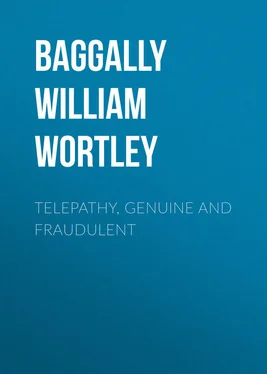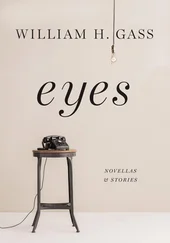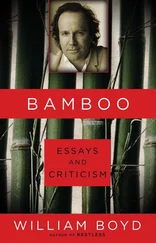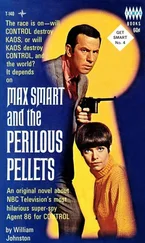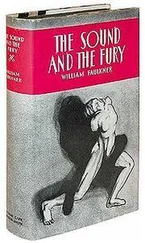William Baggally - Telepathy, Genuine and Fraudulent
Здесь есть возможность читать онлайн «William Baggally - Telepathy, Genuine and Fraudulent» — ознакомительный отрывок электронной книги совершенно бесплатно, а после прочтения отрывка купить полную версию. В некоторых случаях можно слушать аудио, скачать через торрент в формате fb2 и присутствует краткое содержание. Жанр: foreign_antique, foreign_prose, на английском языке. Описание произведения, (предисловие) а так же отзывы посетителей доступны на портале библиотеки ЛибКат.
- Название:Telepathy, Genuine and Fraudulent
- Автор:
- Жанр:
- Год:неизвестен
- ISBN:нет данных
- Рейтинг книги:4 / 5. Голосов: 1
-
Избранное:Добавить в избранное
- Отзывы:
-
Ваша оценка:
- 80
- 1
- 2
- 3
- 4
- 5
Telepathy, Genuine and Fraudulent: краткое содержание, описание и аннотация
Предлагаем к чтению аннотацию, описание, краткое содержание или предисловие (зависит от того, что написал сам автор книги «Telepathy, Genuine and Fraudulent»). Если вы не нашли необходимую информацию о книге — напишите в комментариях, мы постараемся отыскать её.
Telepathy, Genuine and Fraudulent — читать онлайн ознакомительный отрывок
Ниже представлен текст книги, разбитый по страницам. Система сохранения места последней прочитанной страницы, позволяет с удобством читать онлайн бесплатно книгу «Telepathy, Genuine and Fraudulent», без необходимости каждый раз заново искать на чём Вы остановились. Поставьте закладку, и сможете в любой момент перейти на страницу, на которой закончили чтение.
Интервал:
Закладка:
W. W. Baggally
Telepathy, Genuine and Fraudulent
My friend, Mr. W. W. Baggally, an experienced investigator of supernormal phenomena, has set down some of his experiences in connexion with the subject of Telepathy, and I heartily commend his book to the public as the record of a careful, conscientious, and exceptionally skilled and critical investigator. It would be difficult to find anyone more competent by training and capacity to examine into the genuineness of these subtle and elusive phenomena, which yet are of the utmost importance in the development of psychological science. Telepathy, or the direct action of mind on mind apart from the ordinary channels of sense, opens a new chapter; it is not a coping-stone completing an erection, but a foundation-stone on which to build.
OLIVER J. LODGEPART I
GENUINE TELEPATHY
Sir William F. Barrett, one of the founders of the Society for Psychical Research, more than forty years ago tried some experiments which led him to believe that something then new to science, which he provisionally called "thought transference" and which is now known as "telepathy," really existed.
At the first general meeting of the Society, on the 17th July 1882, he read a paper entitled "First Report on Mind Reading."
Since that date the Society has carried out a great number of experiments which tend to show that telepathy is a scientific fact. The evidence for its existence is twofold – that which can be gathered experimentally, and that which arises spontaneously. To the first category belong those experiments in the transmission of the images of drawings or diagrams by means of an effort of the will of a person known as the agent to the mind of another person designated the percipient , when the transmission is carried out otherwise than through the ordinary channel of the senses. To the second category belong those hallucinations of seeing a person at the moment of death or at a crisis, evidence for which has been obtained abundantly by the Society for Psychical Research and has been embodied in the work Phantasms of the Living , and in the Census of Hallucinations – a report on which appeared in the Proceedings of the Society in 1894.
There are several theories to explain the action of telepathy. The first compares it to wireless telegraphy. On this hypothesis it is supposed that it is due to ethereal wave action: – Thought causes motion in the brain cells of the agent, the cells then impart motion to the surrounding ether in the form of waves which impinge on the brain cells of the percipient and give rise to a corresponding thought to that which started the ethereal wave motion.
This theory offers great difficulties. An opponent to it points out that "A wireless message is transmitted by a succession of single ethereal wave impulses produced by the electric sparks at the starting station and received by the coherer at the receiving station, whereas a diagram to be transmitted would require a number of brain-waves produced simultaneously and arranged in the form of the diagram."
Another mode of putting the matter recently advanced is that the agent does not transmit his thought, but that the percipient reads clairvoyantly what is in the agent's mind.
There is also the spiritualistic theory. It is asserted that an external entity, or spirit, conveys the images or thoughts from one mind to another.
Another theory is that telepathy takes place in the subconscious mind, and that the subconscious mind of the agent is in communication with the subconscious mind of the percipient by means of the universal mind underlying all things and of which individual subconscious minds form part.
Not one of these theories has been accepted as proved by the Society for Psychical Research. In cases of spontaneous telepathy it is now generally believed that the appearance of a person at the time of death or at a crisis is not caused by an objective bodily ghost, but arises from a telepathic impact from the agent formulating itself into his image in the mind of the percipient.
In the case of two persons seeing an apparition at the same time, this may be due to the two percipients receiving each, separately, a telepathic impression, or there may be only one percipient who telepathically impresses the hallucination on the mind of the second person.
I will now proceed to relate some cases of telepathy which have come under my personal observation. My first experiment in the transmission of images of drawings and diagrams took place in the rooms of the Society for Psychical Research in May 1902. A private lady, Miss M. Telbin, acted as percipient, and I acted as agent. There were present at the time Mr. J. G. Piddington, Honorary Secretary of the Society, and Mr. Thomas, the then Acting Secretary.
During the first experiment Miss Telbin, who was a stranger to me, sat with her back towards a large opaque screen. In front of her stood a small table upon which rested a crystal ball. She was asked to gaze at the crystal and to describe any vision that might appear to form itself therein. I may parenthetically remark that the object of crystal-gazing is to concentrate the mind and to withdraw it from outward influences. The vision seen in the crystal does not exist objectively, but only in the mind of the seer. On the other side of the screen, entirely hidden from the view of Miss Telbin, sat Mr. Piddington and myself. This gentleman proceeded to take from a box, which was behind the screen and on the floor between his and my chairs, various articles, and to hand them silently, one at a time, to me. I then concentrated my thoughts successively on each article. Miss Telbin gave an account of what she saw in the crystal, and Mr. Thomas, who sat in such a position that both Mr. Piddington and myself were hidden from his view, took notes of what occurred.
The first article handed me was a Windsor Magazine , on the cover of which there was an engraving of Windsor Castle. I concentrated my thoughts on this engraving, and Miss Telbin then gave a description of the vision that presented itself to her mental view.
She first observed that she could see trees on the left side of the picture, and cottages also on the left, and that there was water.
These details were correct so far as they went, but the subsequent details that she gave were incorrect, and the experiment was abandoned as a failure. I then replaced the magazine in the box from which it had been taken, so that Miss Telbin had no opportunity of seeing the magazine during the experiment nor after.
Other experiments were being tried when Miss Telbin spontaneously said that she had had a vision of Windsor Castle.
This experiment may be regarded as a case of deferred telepathy.
Another experiment with the same lady, in which simultaneous double telepathy occurred, is of better evidential value.
Miss Telbin again sat with her back to the screen, and instead of the crystal a piece of paper and a pencil were placed on the table in front of her.
This time Mr. Thomas and I sat behind the screen hidden from her view, and Mr. J. G. Piddington took notes. Mr. Thomas and I acted as simultaneous agents. We each held a small piece of cardboard with a diagram on it known to the agent viewing it, but not to the other agent. These diagrams belonged to the Society for Psychical Research and had not been seen by Mr. Thomas nor by me previous to the experiment. They were in a box which was at our feet behind the screen. We each took a diagram from the box, taking care that we did not see each other's diagram.
We concentrated our minds on our respective diagrams, and Miss Telbin drew her impressions on the piece of paper in front of her. The following drawings show the results: —
Читать дальшеИнтервал:
Закладка:
Похожие книги на «Telepathy, Genuine and Fraudulent»
Представляем Вашему вниманию похожие книги на «Telepathy, Genuine and Fraudulent» списком для выбора. Мы отобрали схожую по названию и смыслу литературу в надежде предоставить читателям больше вариантов отыскать новые, интересные, ещё непрочитанные произведения.
Обсуждение, отзывы о книге «Telepathy, Genuine and Fraudulent» и просто собственные мнения читателей. Оставьте ваши комментарии, напишите, что Вы думаете о произведении, его смысле или главных героях. Укажите что конкретно понравилось, а что нет, и почему Вы так считаете.
